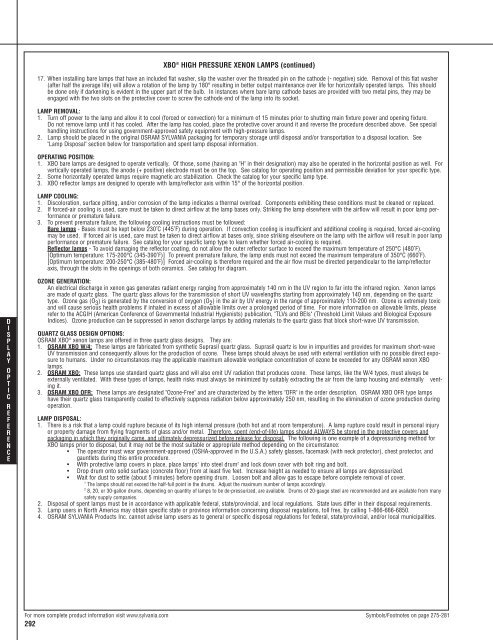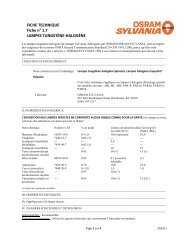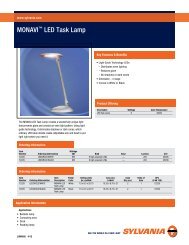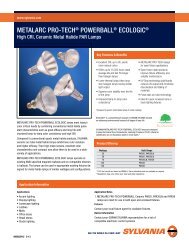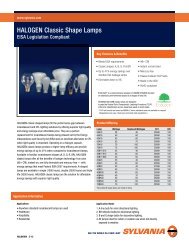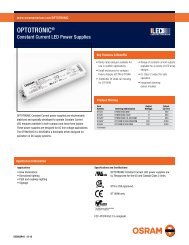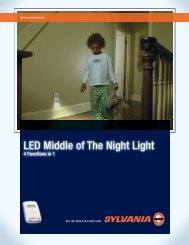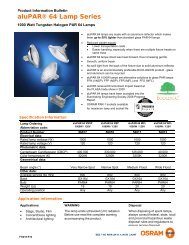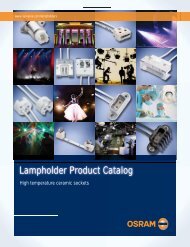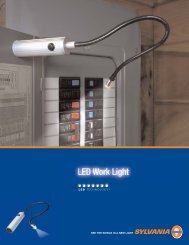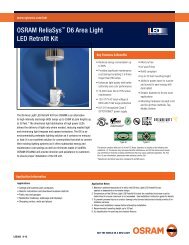Lamp and Ballast Catalog - Osram Sylvania
Lamp and Ballast Catalog - Osram Sylvania
Lamp and Ballast Catalog - Osram Sylvania
Create successful ePaper yourself
Turn your PDF publications into a flip-book with our unique Google optimized e-Paper software.
D ISPLAY<br />
O PTIC<br />
R EFE<br />
R E<br />
N CE<br />
XBO ® HIGH PRESSURE XENON LAMPS (continued)<br />
17. When installing bare lamps that have an included flat washer, slip the washer over the threaded pin on the cathode (- negative) side. Removal of this flat washer<br />
(after half the average life) will allow a rotation of the lamp by 180° resulting in better output maintenance over life for horizontally operated lamps. This should<br />
be done only if darkening is evident in the upper part of the bulb. In instances where bare lamp cathode bases are provided with two metal pins, they may be<br />
engaged with the two slots on the protective cover to screw the cathode end of the lamp into its socket.<br />
LAMP REMOVAL:<br />
1. Turn off power to the lamp <strong>and</strong> allow it to cool (forced or convection) for a minimum of 15 minutes prior to shutting main fixture power <strong>and</strong> opening fixture.<br />
Do not remove lamp until it has cooled. After the lamp has cooled, place the protective cover around it <strong>and</strong> reverse the procedure described above. See special<br />
h<strong>and</strong>ling instructions for using government-approved safety equipment with high-pressure lamps.<br />
2. <strong>Lamp</strong> should be placed in the original OSRAM SYLVANIA packaging for temporary storage until disposal <strong>and</strong>/or transportation to a disposal location. See<br />
"<strong>Lamp</strong> Disposal" section below for transportation <strong>and</strong> spent lamp disposal information.<br />
OPERATING POSITION:<br />
1. XBO bare lamps are designed to operate vertically. Of those, some (having an "H" in their designation) may also be operated in the horizontal position as well. For<br />
vertically operated lamps, the anode (+ positive) electrode must be on the top. See catalog for operating position <strong>and</strong> permissible deviation for your specific type.<br />
2. Some horizontally operated lamps require magnetic arc stabilization. Check the catalog for your specific lamp type.<br />
3. XBO reflector lamps are designed to operate with lamp/reflector axis within 15° of the horizontal position.<br />
LAMP COOLING:<br />
1. Discoloration, surface pitting, <strong>and</strong>/or corrosion of the lamp indicates a thermal overload. Components exhibiting these conditions must be cleaned or replaced.<br />
2. If forced-air cooling is used, care must be taken to direct airflow at the lamp bases only. Striking the lamp elsewhere with the airflow will result in poor lamp performance<br />
or premature failure.<br />
3. To prevent premature failure, the following cooling instructions must be followed:<br />
Bare lamps - Bases must be kept below 230˚C (445˚F) during operation. If convection cooling is insufficient <strong>and</strong> additional cooling is required, forced air-cooling<br />
may be used. If forced air is used, care must be taken to direct airflow at bases only, since striking elsewhere on the lamp with the airflow will result in poor lamp<br />
performance or premature failure. See catalog for your specific lamp type to learn whether forced air-cooling is required.<br />
Reflector lamps - To avoid damaging the reflector coating, do not allow the outer reflector surface to exceed the maximum temperature of 250°C (480˚F).<br />
[Optimum temperature: 175-200°C (345-390˚F)] To prevent premature failure, the lamp ends must not exceed the maximum temperature of 350°C (660˚F).<br />
[Optimum temperature: 200-250°C (385-480˚F)] Forced air-cooling is therefore required <strong>and</strong> the air flow must be directed perpendicular to the lamp/reflector<br />
axis, through the slots in the openings of both ceramics. See catalog for diagram.<br />
OZONE GENERATION:<br />
An electrical discharge in xenon gas generates radiant energy ranging from approximately 140 nm in the UV region to far into the infrared region. Xenon lamps<br />
are made of quartz glass. The quartz glass allows for the transmission of short UV wavelengths starting from approximately 140 nm, depending on the quartz<br />
type. Ozone gas (O 3 ) is generated by the conversion of oxygen (O 2 ) in the air by UV energy in the range of approximately 110-200 nm. Ozone is extremely toxic<br />
<strong>and</strong> will cause serious health problems if inhaled in excess of allowable limits over a prolonged period of time. For more information on allowable limits, please<br />
refer to the ACGIH (American Conference of Governmental Industrial Hygienists) publication, "TLVs <strong>and</strong> BEIs" (Threshold Limit Values <strong>and</strong> Biological Exposure<br />
Indices). Ozone production can be suppressed in xenon discharge lamps by adding materials to the quartz glass that block short-wave UV transmission.<br />
QUARTZ GLASS DESIGN OPTIONS:<br />
OSRAM XBO ® xenon lamps are offered in three quartz glass designs. They are:<br />
1. OSRAM XBO W/4: These lamps are fabricated from synthetic Suprasil quartz glass. Suprasil quartz is low in impurities <strong>and</strong> provides for maximum short-wave<br />
UV transmission <strong>and</strong> consequently allows for the production of ozone. These lamps should always be used with external ventilation with no possible direct exposure<br />
to humans. Under no circumstances may the applicable maximum allowable workplace concentration of ozone be exceeded for any OSRAM xenon XBO<br />
lamps.<br />
2. OSRAM XBO: These lamps use st<strong>and</strong>ard quartz glass <strong>and</strong> will also emit UV radiation that produces ozone. These lamps, like the W/4 types, must always be<br />
externally ventilated. With these types of lamps, health risks must always be minimized by suitably extracting the air from the lamp housing <strong>and</strong> externally venting<br />
it.<br />
3. OSRAM XBO OFR: These lamps are designated "Ozone-Free" <strong>and</strong> are characterized by the letters "OFR" in the order description. OSRAM XBO OFR type lamps<br />
have their quartz glass transparently coated to effectively suppress radiation below approximately 250 nm, resulting in the elimination of ozone production during<br />
operation.<br />
LAMP DISPOSAL:<br />
1. There is a risk that a lamp could rupture because of its high internal pressure (both hot <strong>and</strong> at room temperature). A lamp rupture could result in personal injury<br />
or property damage from flying fragments of glass <strong>and</strong>/or metal. Therefore, spent (end-of-life) lamps should ALWAYS be stored in the protective covers <strong>and</strong><br />
packaging in which they originally came, <strong>and</strong> ultimately depressurized before release for disposal. The following is one example of a depressurizing method for<br />
XBO lamps prior to disposal, but it may not be the most suitable or appropriate method depending on the circumstance:<br />
• The operator must wear government-approved (OSHA-approved in the U.S.A.) safety glasses, facemask (with neck protector), chest protector, <strong>and</strong><br />
gauntlets during this entire procedure.<br />
• With protective lamp covers in place, place lamps1 into steel drum2 <strong>and</strong> lock down cover with bolt ring <strong>and</strong> bolt.<br />
• Drop drum onto solid surface (concrete floor) from at least five feet. Increase height as needed to ensure all lamps are depressurized.<br />
• Wait for dust to settle (about 5 minutes) before opening drum. Loosen bolt <strong>and</strong> allow gas to escape before complete removal of cover.<br />
1<br />
The lamps should not exceed the half-full point in the drums. Adjust the maximum number of lamps accordingly.<br />
2<br />
8, 20, or 30-gallon drums, depending on quantity of lamps to be de-pressurized, are available. Drums of 20-gauge steel are recommended <strong>and</strong> are available from many<br />
safety supply companies.<br />
2. Disposal of spent lamps must be in accordance with applicable federal, state/provincial, <strong>and</strong> local regulations. State laws differ in their disposal requirements.<br />
3. <strong>Lamp</strong> users in North America may obtain specific state or province information concerning disposal regulations, toll free, by calling 1-866-666-6850.<br />
4. OSRAM SYLVANIA Products Inc. cannot advise lamp users as to general or specific disposal regulations for federal, state/provincial, <strong>and</strong>/or local municipalities.<br />
For more complete product information visit www.sylvania.com Symbols/Footnotes on page 275-281<br />
292


